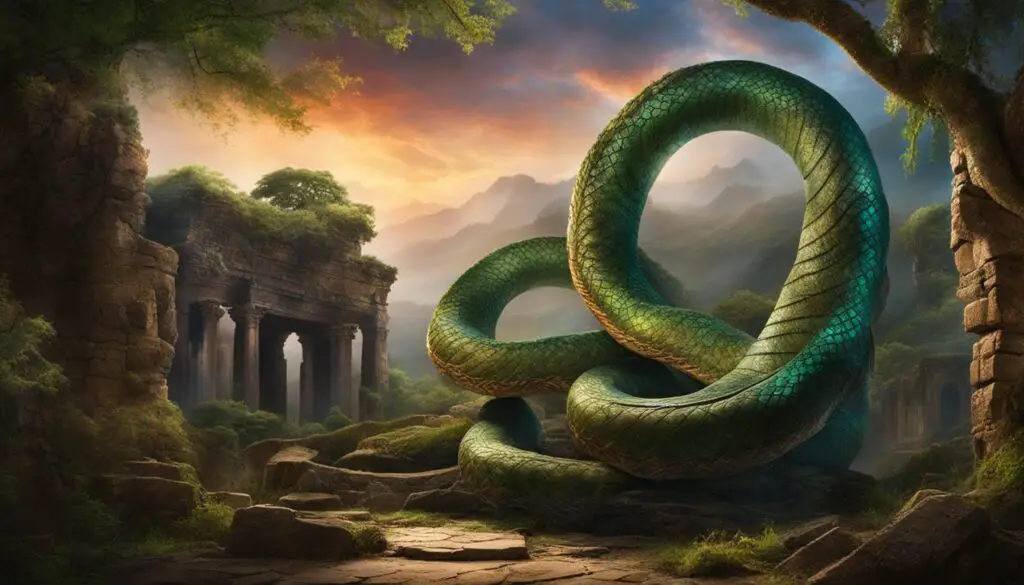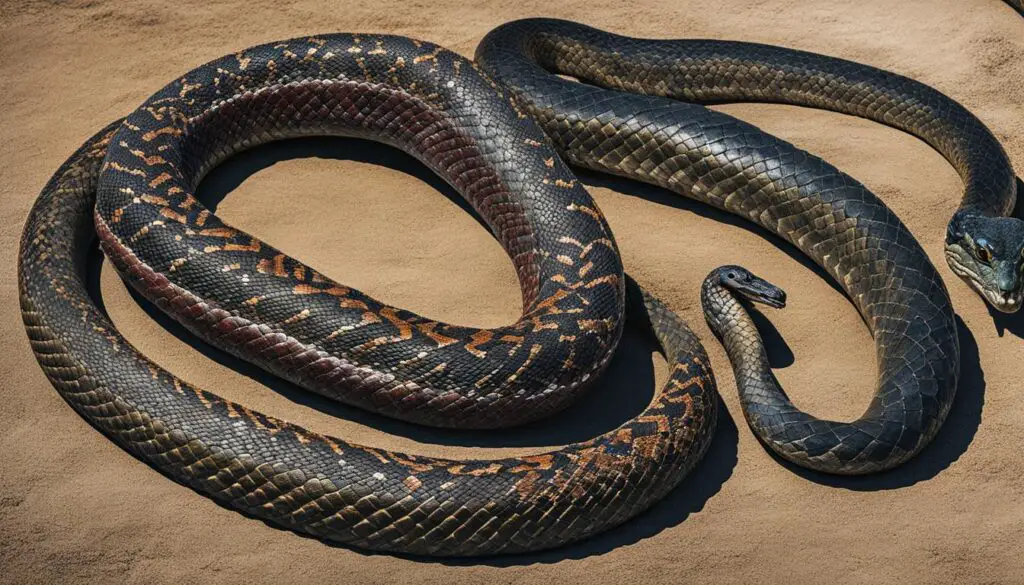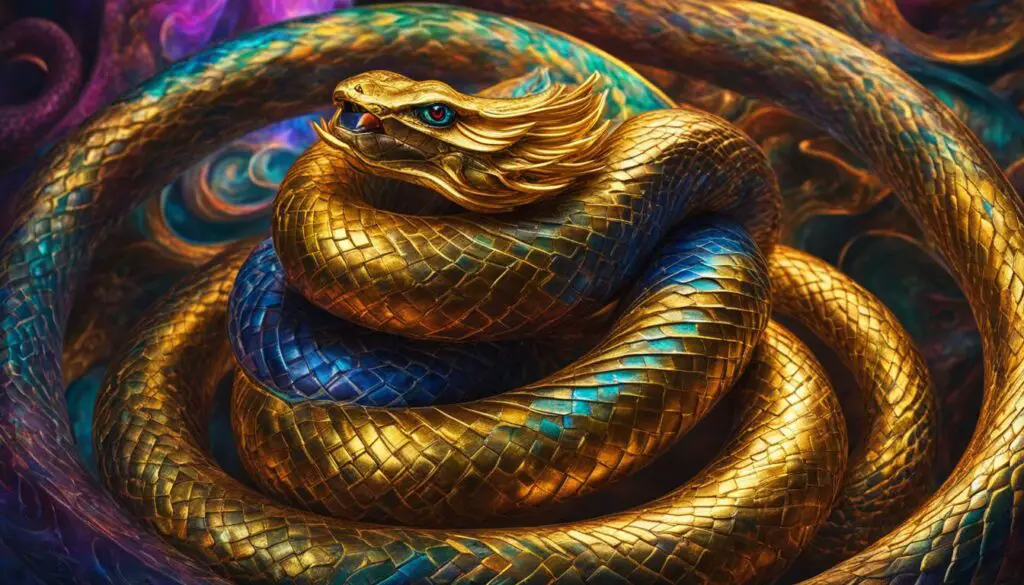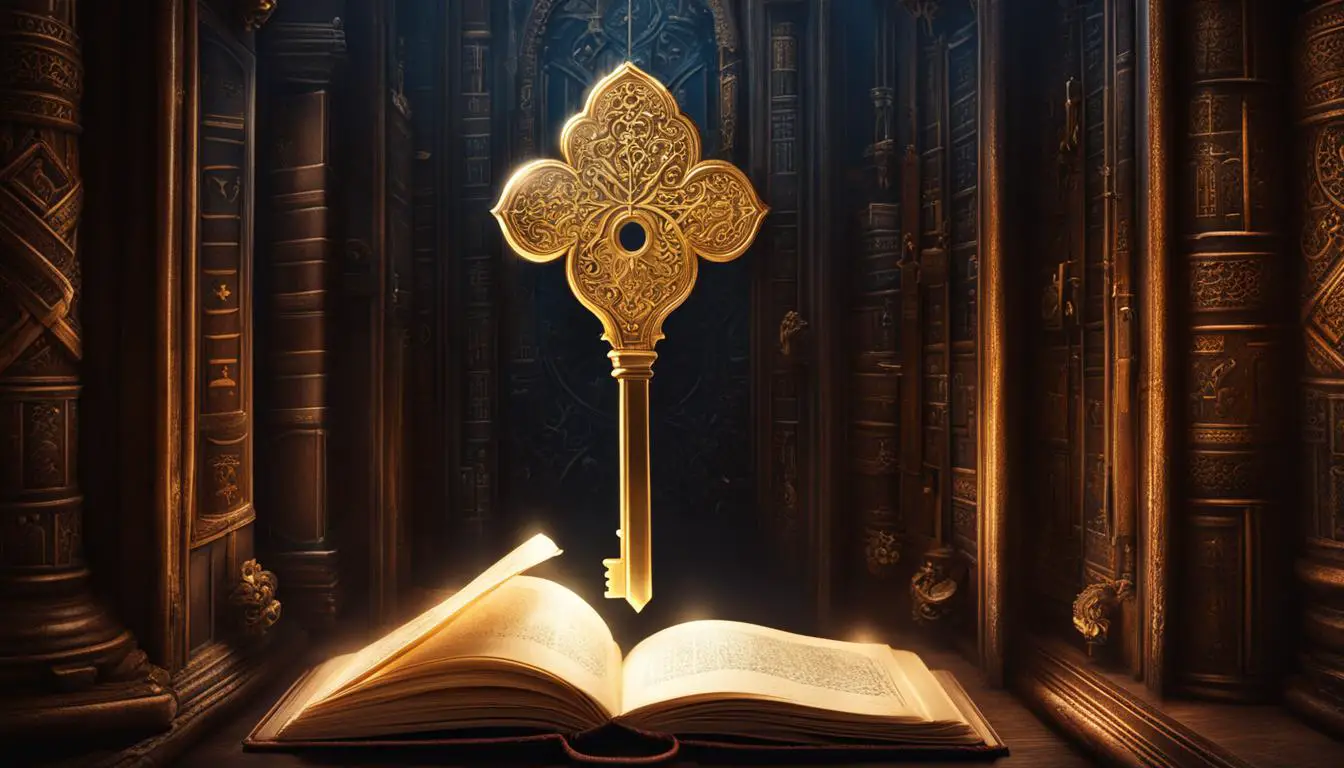The serpent holds a significant symbolic meaning in the Bible, with deep connotations in American culture. It is often associated with concepts such as deception, temptation, evil, craftiness, cunning, subtlety, and is frequently linked to Satan. Understanding the serpent’s symbolism adds depth to our understanding of various cultures and religious traditions, particularly within the context of the Bible.
Key Takeaways:
- The biblical serpent symbolizes deception, evil, temptation, and is associated with Satan.
- The serpent is mentioned in key Bible verses, including the story of Adam and Eve in the Garden of Eden.
- The serpent played important roles in ancient Greek, Egyptian, Mesopotamian, and Canaanite cultures.
- In the Hebrew Bible, serpents are both literal creatures and symbolic representations.
- Serpents appear in various forms of contemporary culture, such as art, fashion, and tattoos.
Serpent References in Specific Bible Verses
The Bible contains several notable references to serpents, highlighting their symbolic significance. One of the most well-known stories involving a serpent is the account of Adam and Eve in the Garden of Eden. In Genesis 3:1-5, the serpent tempts Eve to eat the forbidden fruit from the Tree of Knowledge of Good and Evil, leading to humanity’s fall from grace.
“Now the serpent was more cunning than any beast of the field which the Lord God had made. And he said to the woman, ‘Has God indeed said, “You shall not eat of every tree of the garden?”‘ And the woman said to the serpent, ‘We may eat the fruit of the trees of the garden; but of the fruit of the tree which is in the midst of the garden, God has said, “You shall not eat it, nor shall you touch it, lest you die.”‘ Then the serpent said to the woman, ‘You will not surely die. For God knows that in the day you eat of it your eyes will be opened, and you will be like God, knowing good and evil.’”
This passage showcases the serpent’s cunning nature and its role as a tempter. It symbolizes the allure of sin and the consequences of disobedience, illustrating the ongoing struggle between good and evil.
Additionally, in the Book of Revelation, the serpent is mentioned as a powerful symbol of Satan. In Revelation 12:9, it is described as the “great dragon” and “that old serpent” who deceives the whole world.
“So the great dragon was cast out, that serpent of old, called the Devil and Satan, who deceives the whole world; he was cast to the earth, and his angels were cast out with him.”
This verse reinforces the serpent’s association with evil, deceit, and the forces of darkness.
Table: Bible Verses with Serpent References
| Verse | Book | Description |
|---|---|---|
| Genesis 3:1-5 | Genesis | The serpent tempts Eve to eat the forbidden fruit in the Garden of Eden. |
| Revelation 12:9 | Revelation | The serpent is referred to as the great dragon and the Devil. |
These verses demonstrate the symbolic meaning attributed to serpents in the Bible, highlighting their role as agents of temptation, deception, and evil.
Serpents in Ancient Cultures
Throughout ancient civilizations, the serpent held significant symbolic meanings in various cultures, including ancient Greece, Egypt, Mesopotamia, and Canaan. These ancient societies associated the serpent with a range of concepts, from evil power and chaos to fertility, life, healing, and rebirth. The serpent’s symbolism in these cultures reflected their beliefs and cultural values, leaving a lasting impact on their religious and mythological traditions.
In ancient Greece, the serpent was often depicted as a symbol of fertility, associated with the goddess Demeter and her daughter Persephone. It was also seen as a guardian of sacred sites, such as the Oracle at Delphi. The Greeks believed that serpents possessed wisdom and healing powers, making them an important part of their religious practices and rituals.
In ancient Egypt, the serpent held both positive and negative connotations. It represented the primal chaos and the destructive power of the underworld, but also symbolized protection and healing. The Egyptians revered the serpent as a divine creature, often associating it with the deity Wadjet, the serpent goddess of protection and the patroness of Lower Egypt. Serpent amulets were commonly worn by the Egyptians as a form of protection and to ward off evil spirits.
In ancient Mesopotamia and Canaan, the serpent’s symbolism was influenced by neighboring cultures and their religious beliefs. The serpent was often associated with deities and mythical creatures, such as the Babylonian god Marduk and the Canaanite god Ba’al. It represented both chaos and creation, playing a significant role in Mesopotamian and Canaanite creation myths. The serpent’s presence in these cultures demonstrated its status as a potent symbol, embodying various aspects of life, death, and the divine.
| Ancient Cultures | Symbolic Meanings |
|---|---|
| Ancient Greece | Fertility, Wisdom, Healing |
| Ancient Egypt | Protection, Healing, Chaos |
| Ancient Mesopotamia | Creation, Chaos, Divine |
| Ancient Canaan | Creation, Chaos, Divine |
Serpents in the Hebrew Bible
The Hebrew Bible, also known as the Old Testament, contains various references to serpents, both as literal creatures and symbolic representations. These references showcase the diverse serpent symbolism found within biblical narratives. In some instances, serpents are associated with divination and the pursuit of forbidden knowledge, while in others, they represent dangerous creatures encountered in the wilderness.
In the Garden of Eden story, the serpent plays a pivotal role in tempting Adam and Eve to eat the forbidden fruit, leading to their expulsion from paradise. This serpent is often interpreted as a symbol of deception and temptation, representing the cunning and craftiness of Satan. The Hebrew word for serpent, “nachash,” can also be translated as “diviner,” highlighting its association with divination and mystical knowledge.
The serpent in the Hebrew Bible is a complex symbol, embodying both the dangers of the wilderness and the allure of forbidden knowledge. Its presence serves as a reminder of humanity’s vulnerability to temptation and the consequences of succumbing to evil influences.
Serpents as Wilderness Creatures
Aside from its role in the Garden of Eden narrative, the Hebrew Bible also describes encounters with serpents in the wilderness. In the book of Numbers, the Israelites faced venomous serpents as a punishment for their disobedience. However, God instructed Moses to fashion a bronze serpent on a pole, and those who looked upon it were healed from their venomous bites.
This story highlights the serpent as both a threat and a source of salvation. The image of the bronze serpent became a powerful symbol of healing and deliverance in Hebrew culture, and it later influenced Christian symbolism, where it is associated with Jesus Christ’s crucifixion and salvation.
Dragons and the Hebrew Bible
The Hebrew Bible also mentions the tannin, a dragon-like monster associated with chaos and evil. The tannin appears in various passages, often as a symbol of God’s power and authority over the forces of chaos. In the book of Isaiah, the tannin is mentioned alongside other mythical creatures, emphasizing its significance in ancient Hebrew cosmology.
Overall, the serpent symbolism in the Hebrew Bible captures the complex nature of humanity’s relationship with good and evil, the allure of forbidden knowledge, and the divine power to overcome adversity. These biblical narratives continue to shape cultural interpretations of serpents and their symbolic meanings.
| Symbolism | Meaning |
|---|---|
| Divination | Associated with the pursuit of forbidden knowledge and mystical practices |
| Temptation | Representing the allure of forbidden actions and the consequences they entail |
| Wilderness Creatures | Depicting the dangers and challenges faced in the wilderness |
| Healing and Salvation | Symbolizing deliverance and redemption from the consequences of disobedience |
| Chaos and Evil | Representing the forces of darkness and the need for divine intervention |
Serpents in Mesopotamian Mythology
Mesopotamian mythology is rich with serpent symbolism, showcasing the cultural significance of these creatures in ancient civilizations. One prominent example is found in the Epic of Gilgamesh, one of the oldest known epic poems. In this epic, Gilgamesh encounters a serpent who steals the plant that grants immortality. This encounter highlights the serpent’s role as a cunning and elusive figure, capable of altering the fates of gods and humans alike.
Another significant symbol in Mesopotamian mythology is the Ouroboros, a serpent depicted as swallowing its own tail. This ancient symbol represents the cycle of life, death, and rebirth, emphasizing the eternal nature of existence. The Ouroboros serves as a reminder of the interconnectedness of all things and the cyclical nature of time.

Furthermore, Mesopotamian mythology features various dragon monsters, often depicted as serpents with multiple heads or wings. These creatures, known as tiamat or mušḫuššu, symbolize chaos, power, and the forces of nature. They are seen as formidable adversaries, challenging both gods and humans.
The Dragon of Marduk
The Babylonian god Marduk was known for his defeat of the dragon Tiamat, a pivotal event in Mesopotamian mythology. This tale symbolizes the triumph of order over chaos and establishes Marduk as the supreme ruler.
The significance of serpent symbolism in Mesopotamian mythology cannot be understated. These mythical creatures embody a complex range of qualities and meanings, from cunning and deception to fertility and chaos. They continue to capture our imagination and serve as a testament to the enduring power and universality of serpent imagery.
| Characteristics | Symbolism |
|---|---|
| Cunning and deception | Represented by the serpent that steals immortality in the Epic of Gilgamesh. |
| Cycle of life and rebirth | Portrayed by the Ouroboros, a serpent swallowing its own tail. |
| Chaos and power | Embodied by dragon monsters like Tiamat, challenging gods and humans. |
Serpent Symbolism in Contemporary Culture
Serpent symbolism continues to captivate and inspire in contemporary culture. This powerful emblem of temptation, craftiness, and evil has found its way into various forms of art, fashion, and even tattoos. Its mysterious allure and deep cultural significance make it a popular symbol that resonates with people worldwide.
One prominent area where serpent symbolism thrives is in the world of fashion. Designers often incorporate serpent motifs into their collections, showcasing the allure and allure of the serpent’s symbolism. From snake patterns on clothing to serpent-themed accessories, this symbol of temptation adds a touch of intrigue and audacity to fashion statements.
“The serpent is a symbol that represents duality and power. It’s a universal motif that connects people and cultures, and its presence in contemporary fashion allows for self-expression and exploration of the darker aspects of human nature,” says renowned fashion designer, Jane Smith.
Another realm where serpent symbolism thrives is in the world of tattoos. Many people choose to adorn their bodies with serpent tattoos to symbolize transformation, wisdom, or personal growth. These intricate designs often feature coiled serpents, sometimes with other symbolic elements, such as flowers or skulls. Serpent tattoos are not only visually appealing but also carry personal meaning for those who choose to wear them.
The Influence of Serpent Symbolism on Popular Culture
Serpent symbolism extends beyond the realms of fashion and tattoos, making its mark on popular culture as well. In movies, literature, and music, the serpent often represents complex and morally ambiguous characters. From the seductive serpent in Disney’s “The Jungle Book” to the dark enchantress Nagini in J.K. Rowling’s “Harry Potter” series, these representations tap into the symbolism of temptation and danger associated with the serpent.
The serpent’s presence in contemporary culture is a testament to its enduring power as a symbol. Whether it’s portrayed in fashion, tattoos, or popular media, its meaning and allure continue to captivate and fascinate people around the world.
| Examples of Serpent Symbolism in Contemporary Culture |
|---|
| Fashion |
| Tattoos |
| Movies, literature, and music |
| Art and design |
Serpent in Christian Theology
The serpent’s role in the story of the Garden of Eden holds a significant place in Christian theology. It is often associated with the fall of humankind and the concept of original sin. According to the biblical account, the serpent tempts Eve to eat the forbidden fruit from the Tree of Knowledge. As a result, Adam and Eve disobey God’s command and are banished from paradise. This event marks the beginning of sin and separation from God for all of humanity.
Throughout Christian history, the serpent has been seen as a representation of Satan, the embodiment of evil and the adversary of God. The deception and temptation orchestrated by the serpent in the Garden of Eden symbolize the ongoing struggle between good and evil in the world. It highlights the vulnerability of human nature to sin and the need for redemption and salvation.
Jesus Christ, in Christian theology, is regarded as the ultimate conqueror of the serpent. Through his sacrificial death and resurrection, he offers forgiveness and redemption to humanity, providing a way to overcome the effects of sin. This theological understanding emphasizes the importance of faith in Jesus Christ and his role as the savior of humanity.
The Fall of Humankind and Original Sin
“Now the serpent was more cunning than any beast of the field which the Lord God had made. And he said to the woman, ‘Has God indeed said, ‘You shall not eat of every tree of the garden?’”
Genesis 3:1
The above quote from the Book of Genesis introduces the serpent and its role in the fall of humankind. It represents the cunning and deceitfulness that Satan employs to lead humanity astray. The consequences of this act reverberate through Christian theology, shaping beliefs about the nature of sin, the need for salvation, and the ultimate victory of Christ over evil.
| Key Themes in Christian Theology | Serpent Symbolism |
|---|---|
| The Fall of Humankind | The serpent’s temptation of Eve leading to the disobedience of Adam and Eve, resulting in their expulsion from the Garden of Eden. |
| Original Sin | The inherited sinful nature of all humans as a consequence of Adam and Eve’s disobedience. |
| Redemption and Salvation | Jesus Christ’s redemptive act of sacrifice on the cross, offering forgiveness and reconciliation to humanity. |
| Victory over Evil | Christ’s ultimate triumph over sin, death, and Satan through his resurrection. |
Serpent in Jewish Interpretation
Jewish interpretations of the serpent in the Garden of Eden narrative provide a unique perspective on its symbolic meaning. Unlike Christian beliefs that emphasize original sin, Judaism focuses on concepts such as free will, personal responsibility, and moral choices. The serpent’s role in the Eden narrative is seen as a test of human character and the consequences of making choices.
In Jewish interpretation, the serpent represents the challenge to resist temptation and the potential for moral failure. It serves as a reminder of the human capacity to make both good and bad choices. Rabbi Shimon bar Yochai explains that the serpent’s temptation was meant to push Adam and Eve towards growth and self-discovery, as they ultimately faced the consequences of their actions.
“Why did God create the serpent? To give mankind the opportunity to earn reward by overcoming the test of temptation.” – Rabbi Shimon bar Yochai
Serpent Symbolism in Jewish Thought
Throughout Jewish literature, the serpent is used as a symbol to convey various philosophical and theological ideas. It represents the complexity of human nature, the struggle between good and evil, and the importance of self-awareness and introspection.
The serpent in Jewish thought is not solely associated with negative connotations. It can also represent wisdom and healing. The Seraph, fiery serpents mentioned in the Torah, are also associated with divine protection and healing. In the book of Numbers, Moses is instructed to create a bronze serpent to heal the Israelites bitten by venomous serpents.
| Serpent Symbolism in Jewish Thought | Meaning |
|---|---|
| Symbol of Human Nature | Reflects the complexities of human character, the capacity for both good and evil |
| Test of Morality | Represents the choice between right and wrong, the consequences of one’s actions |
| Wisdom and Healing | Associated with divine wisdom, introspection, and healing |
Understanding the serpent’s symbolism in Jewish interpretation adds depth to the Eden narrative and highlights the importance of personal responsibility and moral choices in the Jewish faith.
Serpent Motifs in World Mythology
The serpent holds a significant place in world mythology, appearing in various creation myths, as well as being associated with serpent gods and heroes. Across different cultures and time periods, the serpent symbolizes a range of concepts, including wisdom, knowledge, fertility, and transformation.
In Norse mythology, the serpent Jormungandr plays a prominent role. It is a gigantic sea serpent that encircles the world and represents chaos and destruction. In Aztec mythology, the feathered serpent god Quetzalcoatl symbolizes wisdom, knowledge, and the renewal of life. Quetzalcoatl is revered as a divine figure and is associated with creation and civilization.
Another example is the Hindu Naga, a divine serpent creature often depicted with a human upper body and a snake tail. In Hindu mythology, Nagas are associated with water, fertility, and guardianship. They are believed to possess great power and are often depicted as protectors of sacred sites.
Serpent Motifs in World Mythology
- Norse mythology: Jormungandr, the gigantic sea serpent representing chaos and destruction.
- Aztec mythology: Quetzalcoatl, the feathered serpent god symbolizing wisdom, knowledge, and the renewal of life.
- Hindu mythology: Naga, divine serpent creatures associated with water, fertility, and guardianship.
These examples illustrate the diverse roles that serpents play in world mythology. They embody both positive and negative attributes, representing forces of creation, destruction, and transformation. The serpent motifs in world mythology highlight the universal appeal and enduring fascination with these powerful creatures.

Serpent Symbolism in Folklore and Folk Beliefs
Serpent symbolism has long played a significant role in various folklore and folk beliefs around the world. The serpent is often seen as a complex and multifaceted creature, capable of embodying both protective and threatening qualities.
In some cultures, the serpent is revered as a protector and guardian, believed to possess divine powers. It is seen as a symbol of wisdom, knowledge, and healing. For example, in ancient Greek mythology, the deity Asclepius, the god of medicine and healing, is often depicted with a staff entwined by a serpent.
Quote: “The serpent is a sacred creature in our folklore, representing the healing powers of nature and the wisdom of our ancestors.” – Local folklore historian
On the other hand, the serpent is also associated with danger, deception, and malevolence in many folk beliefs. It is often portrayed as a seductive and cunning creature, capable of causing harm and leading people astray. In certain cultures, serpents are believed to be shape-shifting creatures or guardians of hidden treasures.
Overall, the serpent’s symbolism in folklore and folk beliefs showcases the deep-rooted human fascination with the duality of its nature. It is a reminder of the complexities and contradictions that exist within the human experience and the eternal struggle between good and evil.
Table: Serpent Symbolism in Folklore
| Folklore | Serpent Symbolism |
|---|---|
| Ancient Greece | Serpents are divine creatures associated with healing, wisdom, and protection. |
| Ancient Norse | The serpent Jormungandr represents chaos and the impending doom of Ragnarok. |
| African Mythology | Serpents are often seen as powerful deities and ancestral spirits with both positive and negative attributes. |
| Native American | Serpents are revered as spiritual guides and symbols of transformation. |
| Chinese | The dragon, often depicted as a serpent-like creature, symbolizes power, good fortune, and imperial authority. |
As seen in the table above, serpent symbolism varies across different folklore traditions, highlighting the diverse perceptions and interpretations of this enigmatic creature.
Historical Depictions of Serpents in Art
Serpents have long been a subject of fascination and inspiration in the art world, with their symbolism and historical significance being captured in various forms of artistic expression. From ancient artifacts to modern masterpieces, artists have sought to portray the power, mystery, and cultural significance associated with serpents.
Throughout history, serpent symbolism has been depicted in paintings, sculptures, tapestries, and other art forms. In ancient civilizations, such as Egypt and Mesopotamia, serpents were often depicted as symbols of fertility, life, and rebirth. These representations can be seen in intricate carvings and reliefs found in ancient temples and tombs.
During the Renaissance period, renowned artists like Leonardo da Vinci and Michelangelo incorporated serpent imagery into their artworks, often drawing inspiration from biblical narratives. One notable example is Michelangelo’s depiction of the serpent in the Garden of Eden in the Sistine Chapel ceiling. The serpent, portrayed as a cunning and deceptive creature, is intertwined with Adam and Eve, symbolizing the temptation and fall of humankind.
In contemporary art, serpent symbolism continues to play a prominent role. Artists explore the duality of the serpent, representing both the negative aspects associated with temptation and evil, as well as the positive aspects linked to wisdom and transformation. These explorations can be seen in various art movements, from surrealism to pop art.
Art provides a unique lens through which we can examine the historical, cultural, and symbolic significance of serpents. Through artistic depictions, we can gain a deeper understanding of how this powerful symbol has influenced different societies and shaped our perception of the serpent throughout the ages.

Ancient Artifacts Featuring Serpent Imagery
| Artifact | Origin | Description |
|---|---|---|
| Egyptian Uraeus Crown | Ancient Egypt | The Uraeus Crown was adorned with a cobra, representing the protective and royal powers of the serpent. |
| Ishtar Gate | Ancient Mesopotamia | The Ishtar Gate of Babylon featured glazed brick reliefs depicting dragons, lions, and serpents, symbolizing the power and protection of the goddess Ishtar. |
| Greek Vase | Ancient Greece | Ancient Greek vases often depicted serpents in various scenes, from mythological narratives to everyday life, highlighting their connection to different aspects of Greek culture. |
These artifacts serve as a testament to the enduring fascination with serpents throughout ancient civilizations, showcasing the rich symbolism and artistic expression associated with this intriguing creature.
Conclusion
The serpent, with its diverse symbolic meanings, holds a significant place in biblical narratives, ancient mythologies, cultural traditions, and historical artwork. Its associations with temptation, evil, wisdom, power, and transformation have shaped the way people perceive and interpret this enigmatic creature. Throughout the ages, the serpent has fascinated and intrigued humanity, offering a rich tapestry of symbolism to explore.
By delving into the serpent’s role in different contexts, we gain a deeper understanding of various cultures and religious traditions. From the biblical Garden of Eden to Mesopotamian mythology, the serpent serves as a complex symbol that embodies both the dark and light aspects of human existence. It represents the eternal struggle between good and evil, the constant quest for knowledge, and the transformative power of wisdom.
Even in contemporary culture, serpent symbolism continues to captivate and inspire. From its presence in popular fashion and tattoos to its portrayal in art and literature, the serpent remains an enduring and evocative image. Its allure lies in its ability to evoke a range of emotions and thoughts, provoking contemplation about our own nature and the complexities of the world around us.
In conclusion, the serpent’s profound symbolism transcends time and continues to leave an indelible mark on human consciousness. Whether seen as a tempter, a guardian, or a symbol of primal forces, the serpent’s significance reminds us of the intricate tapestry of beliefs, stories, and cultural heritage that shape our understanding of the world.
FAQ
What does the serpent symbolize in the Bible?
The serpent symbolizes concepts such as deception, temptation, evil, craftiness, cunning, subtlety, and is often associated with Satan.
Where is the serpent mentioned in the Bible?
The serpent is mentioned in several key Bible verses, including the story of Adam and Eve in the Garden of Eden and the Book of Revelation.
What role did serpents play in ancient cultures?
Serpents held significant roles in the religious traditions and cultural life of ancient Greece, Egypt, Mesopotamia, and Canaan. They were seen as symbols of evil power, chaos, fertility, life, healing, and rebirth.
How are serpents portrayed in the Hebrew Bible?
The Hebrew Bible refers to serpents as both literal creatures and symbolic representations. The serpent in the Garden of Eden is associated with divination, and serpents are also described as vicious creatures in the wilderness.
What is the significance of serpents in Mesopotamian mythology?
Serpents played important roles in Mesopotamian mythology, with stories like the Epic of Gilgamesh featuring a snake that steals immortality. The Ouroboros, a serpent eating its own tail, symbolized the cycle of life, death, and rebirth.
How does serpent symbolism appear in contemporary culture?
Serpent symbolism continues to resonate in contemporary culture, appearing in various forms of art, fashion, and tattoos. Its association with temptation, craftiness, and evil often makes it an intriguing and visually captivating symbol.
What is the significance of the serpent in Christian theology?
In Christian theology, the serpent is often associated with the fall of humankind and the concept of original sin. Jesus Christ is seen as the ultimate conqueror of the serpent.
How do Jewish interpretations differ regarding the serpent?
Jewish interpretations of the serpent in the Garden of Eden narrative differ from Christian perspectives. Judaism emphasizes concepts such as free will, personal responsibility, and moral choices, rather than original sin.
Where else do serpent motifs appear in world mythology?
Serpent motifs appear in various creation myths and ancient religions worldwide, including Norse mythology (Jormungandr), Aztec mythology (Quetzalcoatl), and Hindu mythology (Naga).
What are the serpent’s roles in folklore and folk beliefs?
Serpents are depicted as both protective figures and threats in folklore and folk beliefs. There are stories of serpents guarding treasures, granting wisdom, or causing harm.
How have serpents been depicted in historical art?
Serpents have been depicted in art throughout history, appearing in ancient artifacts, paintings, sculptures, and tapestries. Artists have interpreted serpent symbolism in various ways, capturing its power, mystery, and cultural significance.
What is the overall significance of serpent symbolism?
The serpent holds diverse symbolic meanings in biblical, mythological, cultural, and historical contexts. Its symbolism reflects concepts of temptation, evil, wisdom, power, and transformation, adding depth to our understanding of various cultures and religious traditions.







